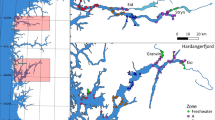Abstract
We recorded the observed and actual swimming speeds of Atlantic salmon and sea trout post-smolts in a Norwegian fjord system, and initiated studies on the orientation mechanisms of the post-smolts. We tracked Atlantic salmon and sea trout with acoustic transmitters for up to 14 h after release. The actual swimming speed and direction of a fish relative to the ground is the vector sum of the observed movements of the fish and the movements of the water. We determined actual swimming speeds and directions of the post-smolts, which reflect their real swimming capacities and orientation, by corrections for the speed and direction of the water current. The post-smolts were actively swimming. The observed direction of movement was dependent on the actual movement of the fish and not the water current. Water currents were not systematically used as an orientation cue either in Atlantic salmon or sea trout, as the actual movements were random compared to the direction of the water current. The actual movement of sea trout were in all compass directions, with no systematic pattern. The Atlantic salmon also moved in all compass directions, but with the lowest frequency of actual movement towards the fjord.
Similar content being viewed by others
References
Asplin, L.,A.G.V. Salvanes & J.B. Kristoffersen. 1999. Non-local wind driven fjord-coast advection and its potential effect on plankton and fish recruitment. Fish. Oceanography 8: 255–263.
Bjørn, P.A.,B. Finstad & R. Kristoffersen. 2001. Salmon lice infection of wild sea trout and Arctic char in marine and freshwaters: The effects of salmon farms. Aquacult. Res. 32: 947–962.
Blackburn, J. & W.C. Clarke. 1987. Revised procedure for the 24 hour seawater challenge test to measure seawater adaptability of juvenile salmonids. Can. Tech. Report Fish. Aquatic Sci. 1515: 1–39.
Fried, S.M., J.D. McCleave & G.W. LaBar. 1978. Seaward migration of hatchery-reared Atlantic salmon, Salmo salar, smolts in the Penobscot River estuary, Maine: Riverine movements. J. Fish. Res. Board Can. 35: 76–87.
Groot, C. 1965. On the orientation of sockeye salmon (Oncorhynchus nerka) during their seaward migration out of lakes. Behaviour (Suppl.) 14: 1–198.
Hansen, L.P.,M. Holm, J.C. Holst & J.A. Jacobsen. 2003. The Ecology of post-smolts of Atlantic salmon. pp.25–39. In: D. Mills (ed.), Salmon at the edge, Blackwell Science
Heuch, P.A. & T.A. Mo. 2001. A model of salmon louse production in Norway: Effects of increasing salmon production and public management measures. Dis. Aquat. Organ. 45: 145–152.
Holm, M.,J.C. Holst, L.P. Hansen, J.A. Jacobsen, N. O'Maoiléidigh & A. Moore. 2003. Migration and distribution of Atlantic salmon post-smolts in the North Sea and North-East Atlantic. pp.7–23. In: D. Mills (ed.), Salmon at the edge, Blackwell Science.
Hvidsten, N.A.,T. Heggberget & A.J. Jensen. 1998. Sea water temperature at Atlantic salmon smolt entrance. Nordic J. Freshwater Res. 74: 79–86.
Jonsson, B. 1985. Life history patterns of freshwater resident and sea-run migrant brown trout in Norway. Trans. Am. Fish. Soc. 114: 182–194.
Knutsen, J.A.,H. Knutsen, J. Gjøsæter & B. Jonsson. 2001. Food of anadromous brown trout at sea. J. Fish Biol. 59: 533–543.
LaBar, G.W., D. McCleave & S.M. Fried. 1978. Seaward migration of hatchery-reared Atlantic salmon (Salmo salar) smolts in the Penobscot River estuary, Maine: Open water movements. Journal du Conseil International pour l'Exploration de la Mer 38: 257–269.
Lacroix, G.L. & P. McCurdy. 1996. Migratory behaviour of post-smolt Atlantic salmon during initial stages of seaward migration. J. Fish Biol. 49: 1086–1101.
Lacroix, G.L. & F.A. Voegeli. 2000. Development of automated monitoring systems for ultrasonic transmitters. pp. 37–50. In: A. Moore & I. Russell (eds.),Advances in fish telemetry, Proceedings of the third conference on fish telemetry in Europe, CEFAS, Lowestoft.
Lucas, M. & E. Baras. 2001. Migration of Freshwater Fishes, Blackwell Science, Oxford.420 pp.
Moore, A. & E.C.E. Potter. 1994. The movement of wild sea trout, Salmo trutta L., smolts through a river estuary. Fish. Manage. Ecol. 1: 1–14.
Moore, A.,G.L. Lacroix & J. Sturlaugsson. 2000. Tracking Atlantic salmon post-smolts in the sea. pp.49–64. In: D. Mills (ed.), The ocean life of Atlantic salmon –environmental and biological factors influencing survival, Fishing News Books, Oxford.
Moore, A.,M. Ives, M. Scott & S. Bamber. 1998. The migratory behaviour of wild sea trout (Salmo trutta L.) smolts in the estuary of the River Conwy, North Wales. Aquaculture 168: 57–68.
Moser, M.L.,A.F. Olson & T.P. Quinn. 1991. Riverine and estuarine migratory behaviour of coho salmon (Oncorhynchus kisutch) smolts. Can. J. Fish. Aquatic Sci. 48: 1670–1678.
Potter, T. & A. Moore. 1991. Salmon migration mystery: Scientists magnetic navigation theory. Fish. News 40 30: 6.
Quinn, T.P. & E.L. Brannon. 1982. The use of celestial and magnetic cues by orienting sockeye salmon smolts. J. Comp. Physiol. A 147: 547–552.
Sigholt, T. & B. Finstad. 1990. Effect of low temperature on sea-water tolerance in Atlantic salmon (Salmo salar) smolts. Aquaculture 84: 167–172.
Stasko A.B.,A.M. Sutterlin, S.A. Rommel Jr.& P.F. Elson. 1973. Migration-orientation of Atlantic salmon (Salmo salar L.). pp.119–137. In: M.W. Smith & W.M. Carter (eds.), International Atlantic Salmon Symposium Special Publication Series 4.
Thorpe, J.E.,L.G. Ross, G. Struthers & W. Watts. 1981. Tracking Atlantic salmon smolts, Salmo salar L., through Loch Voil, Scotland. J. Fish Biol. 19: 519–537.
Tully, O. & D. Nolan. 2002. A review of the population biology and host-parasite interactions of the sea louse Lepeophtheirus salmonis (Copepoda: Caligidae). Parasitology 124: 165–182.
Tully, O.,P. Gargan, W.R. Poole & K.F. Whelan. 1999. Spatial and temporal variation in the infestation of sea trout (Salmo trutta L.) by the caligid copepod Lepeophtheirus salmonis (Krøyer) in relation to sources of infection in Ireland. Parasitology 119: 41–51.
Voegeli, F.A.,G.L. Lacroix & J.M. Anderson. 1998. Development of miniature pingers for tracking Atlantic salmon smolts at sea. Hydrobiologia 371/372: 35–46.
Author information
Authors and Affiliations
Rights and permissions
About this article
Cite this article
Thorstad, E., kland, F., Finstad, B. et al. Migration speeds and orientation of Atlantic salmon and sea trout post-smolts in a Norwegian fjord system. Environmental Biology of Fishes 71, 305–311 (2004). https://doi.org/10.1007/s10641-004-1264-7
Issue Date:
DOI: https://doi.org/10.1007/s10641-004-1264-7




